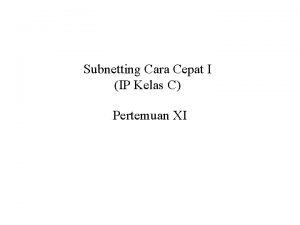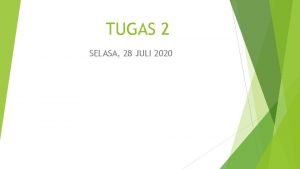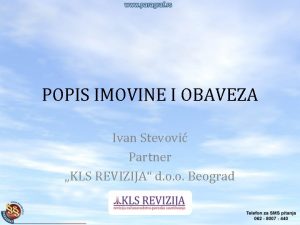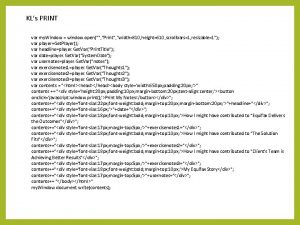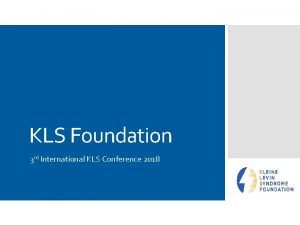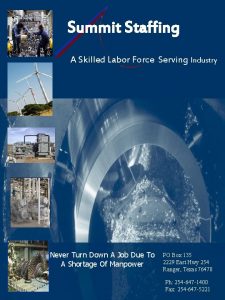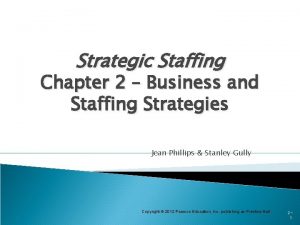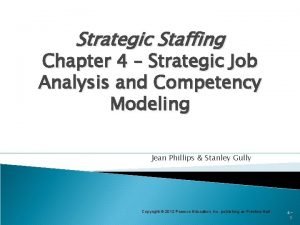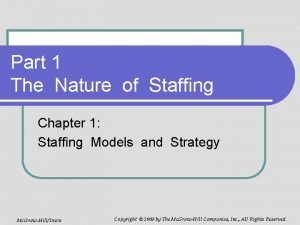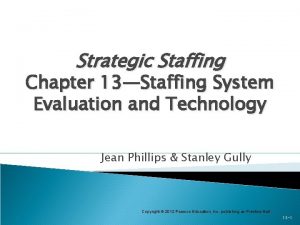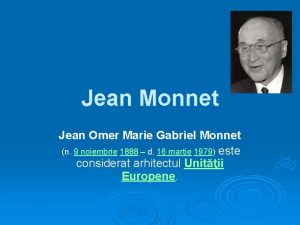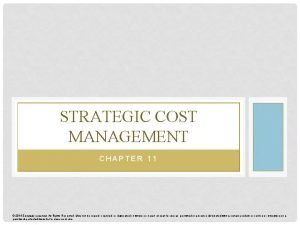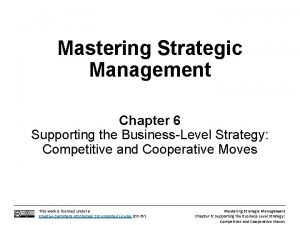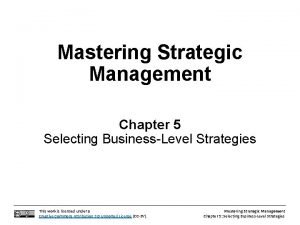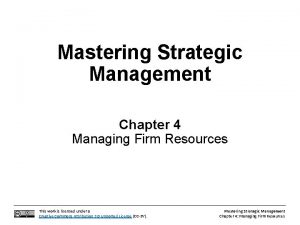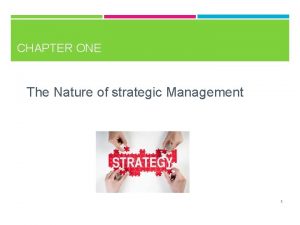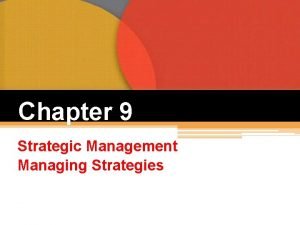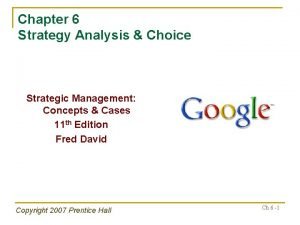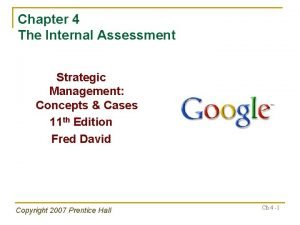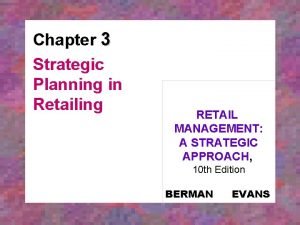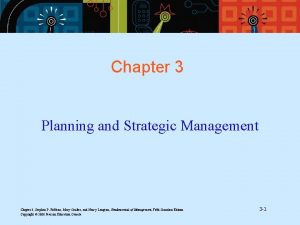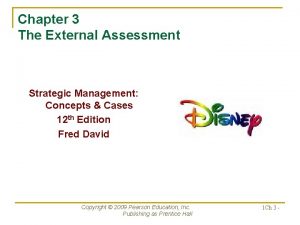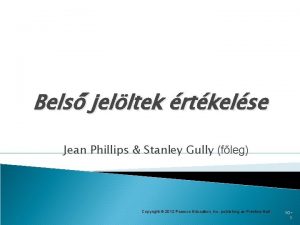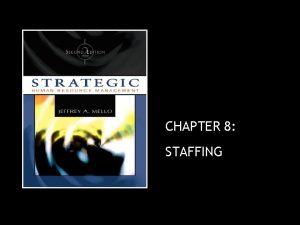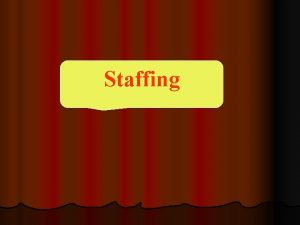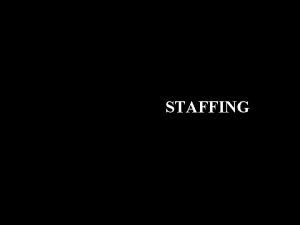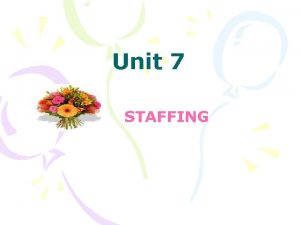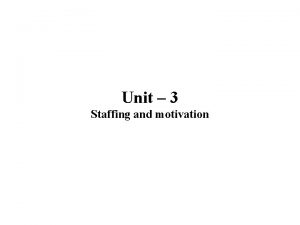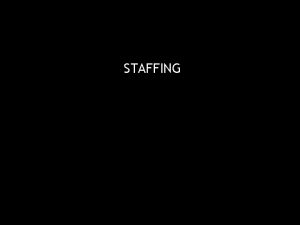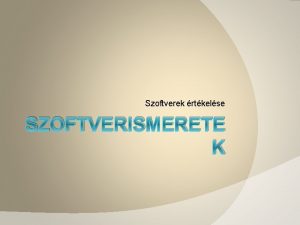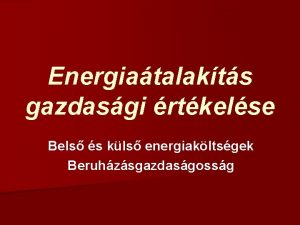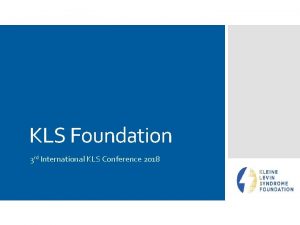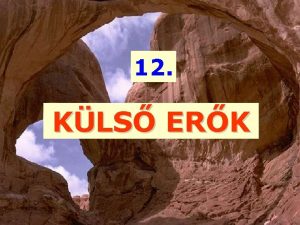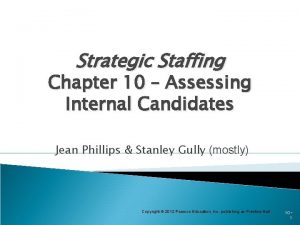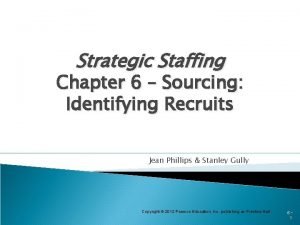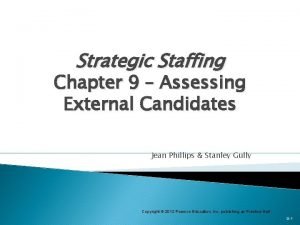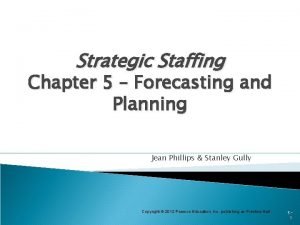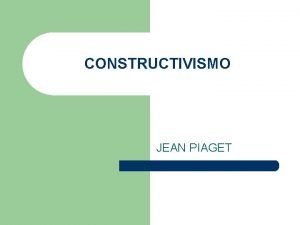Strategic Staffing Chapter 9 Kls jelltek rtkelse Jean

































- Slides: 33

Strategic Staffing Chapter 9 – Külső jelöltek értékelése Jean Phillips & Stanley Gully Copyright © 2012 Pearson Education, Inc. publishing as Prentice Hall 91

A külső jelöltek értékelésének céljai Illeszkedés maximalizálása Pontos értékelés ROI maximalizálása Pozitív érdekelti reakciók kiváltása Az EEM filozófia és stratégia támogatása A munkaadói imázs megteremtése és megerősítése Azonosítani az új munkatársak fejlődési igényeit Etikus értékelés Megfelelni a jogszabályi előírásoknak Copyright © 2012 Pearson Education, Inc. publishing as Prentice Hall 92

Megfelelés dimenziói Copyright © 2012 Pearson Education, Inc. publishing as Prentice Hall 93

Személy – állás megfelelés Személy Tehetségek (KSAO & kompetenciák) motivációk Állás Követelmények jutalmazás Copyright © 2012 Pearson Education, Inc. publishing as Prentice Hall 94

Kiegészítő és helyettesítő illeszkedés Kiegészítő (komplementer) illeszkedés: ha az új tag egy addig meg nem lévő dolgot nyújt a szervezetnek, különbözik a többiektől Helyettesítő illeszkedés: Ha az új tag hasonló a többiekhez Copyright © 2012 Pearson Education, Inc. publishing as Prentice Hall 95

Lehetséges kiválasztási kimenetek Elsőfajú hiba Másodfajú hiba Copyright © 2012 Pearson Education, Inc. publishing as Prentice Hall 96

Dollar Return on Investment Copyright © 2012 Pearson Education, Inc. publishing as Prentice Hall 97

Return on Investment The savings from avoiding bad hires reflects the fact that bad hires can actually cost the organization money. The return on investment from a new assessment method is the sum of the economic value of improved performance and the savings from avoiding bad hires. Although staffing should be seen as an investment rather than a cost, cost is still important for many companies that simply don’t have the money to invest in more expensive systems even if they are more accurate at identifying the best new hires. The formula provides a way to estimate the return on investment of any new assessment method. Copyright © 2012 Pearson Education, Inc. publishing as Prentice Hall 98

Fejlesztési szükségletek meghatározása Az értékelési módszerek fejlesztési szükségleteit is azonosíthatják. ◦ If a top candidate’s assessment scores show that his or her organization and time management skills are good but their customer service skills need further development, post-hire training can improve these skills. Egyes értékelési módszerek a jelentkezők preferált tanulási stílusát is azonosíthatják, ami csökkentheti a betanítási időt, javíthatja annak hatékonyságát és a megtartást. Copyright © 2012 Pearson Education, Inc. publishing as Prentice Hall 9 -9

Legal Compliance (from the UGESP) A test of knowledge and abilities may be used if it measures a representative sample of knowledge, skills, or abilities that are necessary to perform the job and are operationally defined. Knowledge ◦ Must be defined in terms of behavior. ◦ Each knowledge must be part of a body of learned information that is used in and necessary for required and observable job behaviors. Abilities ◦ Must be defined in terms of observable aspects of job behavior. ◦ Each ability should be necessary for the performance of important work behaviors. ◦ Any selection procedure measuring an ability should closely approximate an observable work behavior. To the extent that the setting and manner of the administration of the selection procedure fail to resemble the work situation, the less likely it is that the selection procedure is content valid, and the greater the need for other validity evidence. Copyright © 2012 Pearson Education, Inc. publishing as Prentice Hall 910

Hiring Stages When people first apply for a job, they are considered job applicants and are evaluated against the minimum acceptable criteria for the job, such as relevant education and skills. Those applicants passing the initial screen are considered job candidates and are assessed in more depth to evaluate their characteristics and qualifications as defined by the job specification as well as on dimensions relevant to personorganization and even person-group and personsupervisor fit. ◦ A series of evaluative assessments are often performed, with the lowest performing candidates being screened out after each phase. The organization then makes its hiring decision from the group of finalists that remains after all assessment methods have been completed. Copyright © 2012 Pearson Education, Inc. publishing as Prentice Hall 9 -11

Some External Assessment Methods Szűrő módszerek ◦ ◦ Resumes and cover letters Job applications and weighted application blanks Biographical information Telephone screens ◦ ◦ ◦ ◦ Cognitive and noncognitive ability tests Values assessments Personality assessments Integrity tests Polygraph tests Job knowledge tests Interviews (structured and unstructured) Behavioral and situational interviews Situational judgment tests Graphology Job simulations Work samples Reference checks Értékelő módszerek Feltételes módszerek ◦ Medical and drug tests, and background checks Copyright © 2012 Pearson Education, Inc. publishing as Prentice Hall 9 -12

Jelentkezési űrlapok Standard jelentkezési űrlap (standard application blank (SAB)): A standardized application form used to obtain biodata on the candidates for a job. Enables objective scoring of the candidates according to the information supplied. Súlyozott jelentkezési űrlap (weighted application blank (WAB)): Different weightings are applied to the various categories of data according to their importance as predictors of success in the job. Copyright © 2011 Pearson Education, Inc. Publishing as Prentice Hall 113

Gyakran használt értékelési módszerek összehasonlítása 9 -14

Biodata Copyright © 2012 Pearson Education, Inc. publishing as Prentice Hall 9 -15

Cognitive Ability Tests Copyright © 2012 Pearson Education, Inc. publishing as Prentice Hall 9 -16

Strukturált interjú kialakításának lépései Copyright © 2012 Pearson Education, Inc. publishing as Prentice Hall 9 -17

Strukturált interjúk típusai Viselkedés-alapú interjúk: using information about what the applicant has done in the past to predict future behaviors Szituációs interjúk: asking people how they might react to hypothetical situations Both types outperform unstructured interviews and result in scores that can be used to compare candidates Copyright © 2012 Pearson Education, Inc. publishing as Prentice Hall 9 -18

Viselkedés-alapú interjúk Copyright © 2012 Pearson Education, Inc. publishing as Prentice Hall 9 -19

Szituációs intejúkérdés Copyright © 2012 Pearson Education, Inc. publishing as Prentice Hall 9 -20

STAR Technika Viselkedés-alapú interjúkérdésekre adandó válaszok sémája: Situation or Task: describe in enough detail for the interviewer to understand the situation and what you needed to accomplish Action that you took Results that you achieved Copyright © 2012 Pearson Education, Inc. publishing as Prentice Hall 9 -21

Az értékelés módszer hatásosságának értékelése Validity—whether the assessment method predicts relevant components of job performance Return on investment—whether the assessment method generates a financial return that exceeds the cost associated with using it Applicant reactions—including the perceived job relatedness and fairness of the assessment method; perceiving sufficient opportunity to perform, or believing that one had an adequate opportunity to demonstrate one’s ability to do the job, influences perceptions of the fairness of the selection process, particularly if the person is rejected for the job Copyright © 2012 Pearson Education, Inc. publishing as Prentice Hall 9 -22

Az értékelés módszer hatásosságának értékelése Selection ratio—having a low selection ratio means hiring only a few applicants, which allows an assessment method to have maximum impact in improving the performance of the people hired Usability—people in the organization must be willing and able to use the method consistently and correctly Adverse impact—an assessment method is more effective if it predicts job performance and other important hiring outcomes without discriminating against members of a protected class Copyright © 2012 Pearson Education, Inc. publishing as Prentice Hall 9 -23

Nemkívánatos hatások mérséklése Using targeted recruitment to increase the numbers of qualified minority applicants Expanding the definition of job performance to include areas of contextual performance such as commitment and reliability in addition to task performance Combining predictors can reduce adverse impact – if a cognitive ability test predicts job performance but discriminates against women, using it in conjunction with another valid assessment method that either does not have any adverse impact based on sex or that discriminates against men, can reduce or eliminate the adverse impact of the cognitive ability test Using well-developed simulations rather than cognitive ability tests Copyright © 2012 Pearson Education, Inc. publishing as Prentice Hall 9 -24

Nemkívánatos hatások mérséklése Ha végül csak kevés alkalmazott kerül felvételre, használjuk a kevesebb nemkívánatos hatással járó módszereket a korábbi, a többel járókat a későbbi szakaszokban. Sávos értékelések használata (banding): ◦ Think of grades – students scoring from 93 to 100% are placed in the “A” band, from 85 to 95% are placed into the “B” band, etc. ◦ Only the banded score (A, B, C, etc. ) is used to compare applicants ◦ This technique can reduce an assessment’s adverse impact but will also reduce the validity of the test Copyright © 2012 Pearson Education, Inc. publishing as Prentice Hall 9 -25

Értékelési terv A munkaköri elvárások mátrixának elkészítése után meg kell határozni a fontos követelmények legmegfelelőbb mérési módszereit. Az értékelési terv leírja: ◦ Which assessment method(s) will be used to assess each of the characteristics on which applicants will be evaluated ◦ In what sequence the assessments will take place ◦ What weight each assessment will receive in determining an overall score for that characteristic based on the importance of each characteristic to job performance. Characteristics that will be trained after hire are not assigned to any assessment method, but any existing qualifications required to qualify for the training program should be listed. Copyright © 2012 Pearson Education, Inc. publishing as Prentice Hall 9 -26

Munkaköri követelmények mátrixa Copyright © 2012 Pearson Education, Inc. publishing as Prentice Hall 4 -27

Értékelési terv Copyright © 2012 Pearson Education, Inc. publishing as Prentice Hall 928

Értékelési módszerek kiválasztása The choice should be based on which methods best assess the applicant characteristics or competencies identified as important during the job analysis as well as the ability of the assessment method to meet other important goals of the external assessment process. Because different methods are good at assessing different things, and differ in their cost, validity, applicant reactions, and adverse impact, it is often necessary to use more than one assessment method. Just because an assessment method results in adverse impact, if it does a good job predicting job performance it may be worthwhile to investigate the usefulness of various strategies to reduce its adverse impact so that it can continue to be used. Copyright © 2012 Pearson Education, Inc. publishing as Prentice Hall 9 -29

Discussion Questions When should employers reassess the assessment methods they use in hiring? Discuss the advantages and disadvantages of both structured and unstructured interviews. Which would you prefer to use? Why go to all the trouble of sometimes costly and time-consuming assessments when there are no guarantees they will result in a successful hire? Copyright © 2012 Pearson Education, Inc. publishing as Prentice Hall 9 -30

Discussion Questions What do you feel are the least effective external assessment methods? Why? Do you think that it is appropriate for employers to research applicants’ backgrounds? What about credit histories? Why or why not? Copyright © 2012 Pearson Education, Inc. publishing as Prentice Hall 9 -31

Opening Vignette Exercise Southwest Airlines believes that it needs employees with creativity, humor, and the ability to work well with others to successfully execute its differentiation strategy. This chapter’s opening vignette provided some information about how the company currently assesses job candidates on these dimensions. Reread the opening vignette and its conclusion, and answer the following questions in a group of 3 -5 people. Be prepared to share your answers with the class. ◦ Do you think it’s appropriate for Southwest Airlines to assess creativity and humor during its assessment process? ◦ How would you react if you went through Southwest’s assessment process? Identify some things that you would both like and dislike and explain why. ◦ Identify two other assessment methods you think Southwest could use to assess applicants’ humor and creativity. Copyright © 2012 Pearson Education, Inc. publishing as Prentice Hall 9 -32

All rights reserved. No part of this publication may be reproduced, stored in a retrieval system, or transmitted, in any form or by any means, electronic, mechanical, photocopying, recording, or otherwise, without the prior written permission of the publisher. Printed in the United States of America. Copyright © 2012 Pearson Education, Inc. publishing as Prentice Hall 9 -33
 Range ip kelas c
Range ip kelas c Kls götzis
Kls götzis Negara yang pertama kali mengolah bahan serat alam adalah
Negara yang pertama kali mengolah bahan serat alam adalah Dozvoljeni manjak na popisu
Dozvoljeni manjak na popisu Klemail
Klemail Kls foundation
Kls foundation Summit staffing
Summit staffing 9 elements of staffing strategy
9 elements of staffing strategy Seven components of strategic staffing
Seven components of strategic staffing Ksao job analysis example
Ksao job analysis example Staffing system components
Staffing system components Staffing efficiency ratio
Staffing efficiency ratio Jean monnet jean-gabriel monnet
Jean monnet jean-gabriel monnet Jean monnet jean-gabriel monnet
Jean monnet jean-gabriel monnet Strategic fit vs strategic intent
Strategic fit vs strategic intent Puppy dog ploy
Puppy dog ploy Strategic competitiveness
Strategic competitiveness Strategic analysis and choice in strategic management
Strategic analysis and choice in strategic management Process of strategic cost management
Process of strategic cost management Strategic management chapter 6
Strategic management chapter 6 Strategic management chapter 5
Strategic management chapter 5 Strategic management chapter 4
Strategic management chapter 4 Nature of strategic management
Nature of strategic management Strategic management
Strategic management Strategic management chapter 7
Strategic management chapter 7 Chapter 7 strategic management
Chapter 7 strategic management Chapter 7 strategic management
Chapter 7 strategic management What are the two external dimensions of the space matrix?
What are the two external dimensions of the space matrix? Integrating strategy and culture in internal assessment
Integrating strategy and culture in internal assessment Retail strategic planning
Retail strategic planning Chapter 3 strategic management
Chapter 3 strategic management Strategic management chapter 7
Strategic management chapter 7 Mis issues in strategy implementation
Mis issues in strategy implementation Strategic management chapter 3
Strategic management chapter 3
